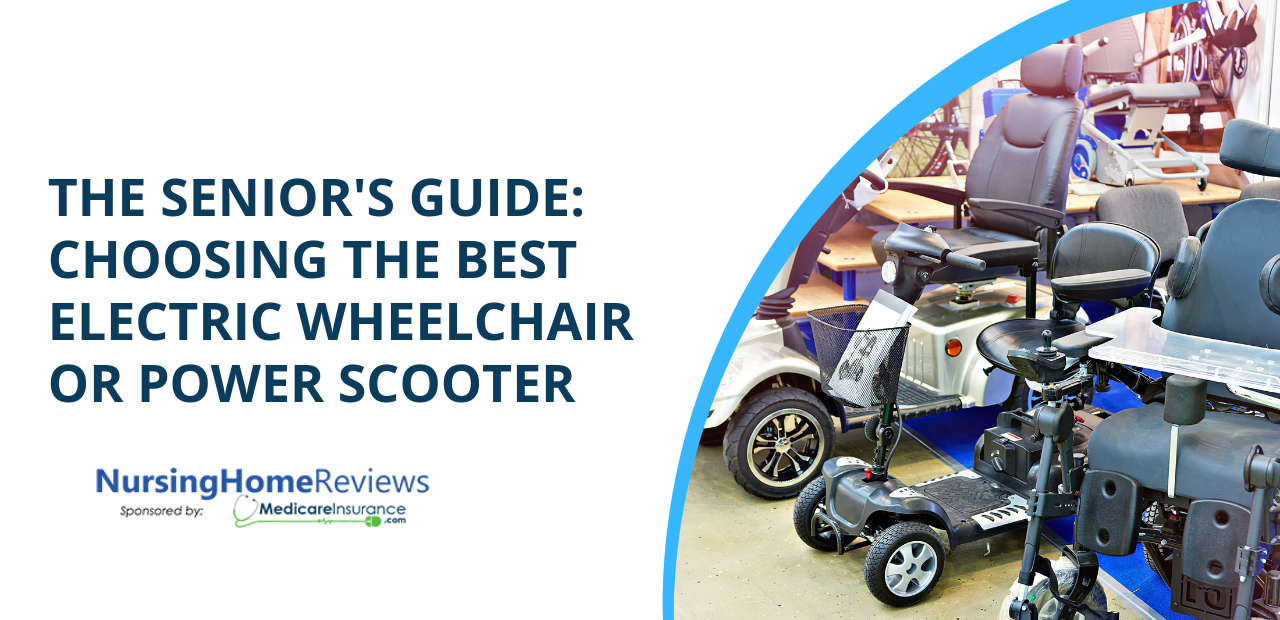
Need new wheels?
Losing mobility is, unfortunately, a common part of growing older. While diet and exercise can help, investing in a good electric wheelchair or power scooter can help you maintain your independence for longer. Still, there are so many options available; how can you find the right ones for you?
What goes into comparing electric wheelchairs or power scooters?
Electric scooters and wheelchairs are beneficial but very expensive. Medicare can help cover the cost, but there are some requirements you need to meet first:
- You need to have a health condition that causes significant difficulty moving around your home.
- You must be unable to do basic daily activities (like bathing, dressing, etc.), even with a cane, crutch, or walker.
- You need to be able to get on and off the wheelchair safely, and you must be able to operate it safely. A caregiver can also operate the device if they are always nearby.
- Your doctor must confirm you have a medical need for a wheelchair.
There’s usually a hierarchy of what Medicare will cover. If you have sufficient upper body strength or a caregiver to assist you, Medicare will first pay for a manual wheelchair. If you lack the strength to operate a manual wheelchair but can still sit up unaided and operate the controls, it’s likely that an electric scooter will be covered. If you cannot correctly sit up or use the controls of a scooter, Medicare may pay for an electric wheelchair.
Many seniors have conditions that make walking for prolonged periods difficult, even if they can move short distances unaided or with a cane or walker. Other health issues, such as heart disease or COPD, can lead to fatigue when walking long distances. Still, even if it’s not strictly medically necessary, an electric mobility device can be a huge help.
So, suppose you don’t currently qualify for Medicare. In that case, you can expect to pay thousands of dollars for a mobility device: making picking the best motorized wheelchair all the more critical.

To Sit or Scoot, That Is the Question
Beyond the medical concerns mentioned above, there are a few other things to consider when choosing between a scooter and a wheelchair, namely, how you’ll use them.
While still technically medical equipment, adult mobility scooters are often framed as convenience devices. They’re designed for people who still have a decent range of mobility but may need help with specific tasks. That’s why they’re a fixture at grocery stores and theme parks.
Scooters are less maneuverable than wheelchairs, as anyone who has tried to turn a scooter around in a grocery store aisle can attest. While swiveling seats can help you orient yourself in specific directions, a power scooter is poorly suited for home use.
There’s often an expectation that people using scooters will be able to stand up under their power or with the aid of a cane, at least briefly. As such, they’re a poor replacement for standard seating. You won’t be able to use a desk or table without awkwardly rotating the seat. In short, if you’re planning on using a mobility device at home or for the majority of your time, a scooter may not be the best choice.
There are certain benefits, however. Scooters are often collapsible, meaning they can be transported without a specialized vehicle. They also come with optional attachments like baskets and headlights, which can make them well suited to utility tasks like shopping or recreational tasks like going for an evening stroll.

Wheelchairs, conversely, are meant for all-day use with minimal transference. As such, they’re a bit more flexible than power scooters. They can make very tight turns, even rotating 360 degrees while in place, and navigate a home with little difficulty (though you may still need to rearrange the furniture).
Most electric wheelchairs allow you to get closer to your bed, table, or desk and can take the place of an ordinary chair in many situations. Some of the most advanced adult mobility scooters and chairs can even come with powered adjustable seats that allow you to reach high shelves. Others allow you to assume a supported standing position. Wheelchairs can also have more varied controls, including joysticks, foot pedals, and “sip and puff” systems to control your chair with your lungs.
The downside to all of this convenience? Price. Without insurance, you can pay thousands more for an electric wheelchair. Looking at Pride Mobility, manufacturers of the popular Jazzy scooter, we can see the difference in pricing immediately: a power scooter ranges in price from just under $1000 for a basic model to over $5000 for their most advanced heavy-duty option. An electric wheelchair, conversely, starts at about $1500 at minimum.
For most people, a scooter will probably be your best option: this assumes that Medicare doesn’t deem the device as medically necessary. Since many of the use cases for a power wheelchair are things that would cause it to be deemed medically necessary, you’ll likely receive some Medicare coverage in those situations. Be aware that a Medicare Advantage plan may have different prerequisites for coverage.
There is some recourse for those who would like a more expensive device but can’t afford to pay out the nose for it: rental. Rentals are much less expensive on a month-to-month basis than purchasing outright, though they will likely cost you more in the long run, even if you rent-to-own. However, if you only need the device infrequently, like for vacations, consider renting only when needed.
The World on Wheels
Beyond the primary considerations for usage, you also want to consider any exceptional use cases for your device: how it handles situations more complex than going to the grocery store or moving around your home.
While an electric mobility device can help you move around at a walking pace, they don’t typically go over a few miles an hour at max speed. Wheelchair-accessible vehicles exist, but you’ll be reliant on ordinary vehicles. If you choose a scooter, they are not designed to be ridden while in a vehicle.
Fortunately, many of these devices are designed to be lightweight and easy to disassemble, allowing them to be stored in the trunk of your vehicle. However, you’ll have an easier time with a larger vehicle like an SUV instead of a sedan.
Another essential consideration is flying. If you’re concerned about leaving your scooter behind because the TSA won’t allow you to bring it on a plane, don’t be: the Air Carrier Access Act of 1986 establishes your right to bring your mobility device directly to the gate of your flight, allowing it to be checked immediately before boarding. This means you can actively use it in the airport, and it will be returned to you immediately upon landing, even if you have a connecting flight.
However, there are still some caveats: you need to contact your airline 48 hours before departure so they can make arrangements for storing your device, and specific devices (like those that use ‘spillable,’ car-style batteries) may not be accommodated on all flights. In addition, this law only applies to airlines that are either departing from or arriving at a destination in the United States or to airlines registered in the US. International flights are subject to local law, depending on where you travel.
Once you get where you’re going, another primary consideration is what you’ll be doing. Most devices will do fine with indoor surfaces and sidewalks, but if you’re headed somewhere a bit rougher, you’ll want a device that can handle the varied terrain. The best power wheelchair for outdoor use will have thick, rugged tires for the drive wheels, allowing you to maintain your grip in unstable conditions. Shock absorbers will also lessen the impact of cobblestone streets or dirt roads. You’ll also want a battery with a decent drive range: most can handle around ten to fifteen miles, which is more than enough for a day trip. If you expect to travel further, consider packing a backup battery if possible: this is easier with lithium-ion batteries, as they’re lighter weight and rechargeable, allowing you to cycle between them as needed.
The mobility device can help you maintain an active lifestyle, allowing you to continue doing the things you love. You deserve to live in a community that lets you do the same. We can help you compare senior communities with ratings, reviews, and violations. Enter your zip code to start your search today.





